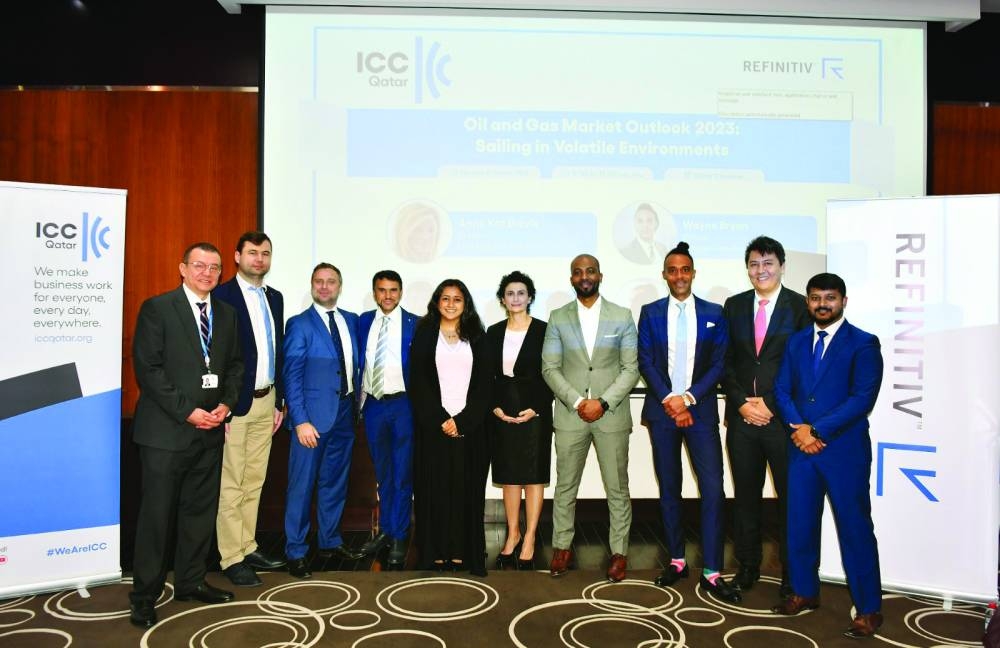The International Chamber of Commerce Qatar (ICC Qatar), in collaboration with Refinitiv held a seminar on the ‘Oil and Gas Market Outlook for 2023’ at Qatar Chamber yesterday.
The seminar was presented by four international experts from Refinitiv: Ranjith Raja, head of EMEA Oil & Shipping Research; Filippo Kassab, director of Analytics Centre of Excellence (ACE); Wayne Bryan, director of European Gas Research; and Anne Kat Brevik, director of LNG Research.
An ICC Qatar representative stated that Qatar pays great importance to the production of energy and renewable energy, and takes “serious steps” towards gradually moving to sustainable, clean energy in line with National Vision 2030.
In addition, Qatar is considered as the largest supplier of Liquefied Natural Gas (LNG) in the world and has been raising its status by having significant investments and scaling their LNG infrastructure and production capacity.
Ahmed Hafez, Refinitiv Country head in Qatar, said Qatar has become synonymous with one of the major energy players not only in the Middle East but globally with its proven natural gas reserves standing at approximately “25tn m3” (“14% of the world’s total natural gas reserves”), which ranks it the third after Russia and Iran.
According to Gas Exporting Countries Forum (GECF), Qatar produced “4.4%” of global production and more than “28%” of the total output in the Middle East in the year 2019. Based on the promising expansion plans and great potential in expanding the gas production capacity, GECF predicts that these shares will increase to “5.5% and 32.2%”, respectively by 2050 when the Qatar’s annual natural gas production is expected to reach the level of more than “320 bcm.”
The seminar emphasised that beyond 2025, the expectation of a tight LNG market is high and that tranches of new supply will alleviate the tightness. Moreover, it highlighted the total demand growth for the upcoming years (from 2023 to 2030), in which Asia represents 76% of total demand growth, meanwhile China stands for 26%. Besides, a structural oversupply-situation from 2028 to 2030 can occur, if a flood of new projects is sanctioned this year or the next.
The seminar also revealed that in 2023, the US ranked as the world’s leading source of supply growth of the oil market along with Canada, Brazil, and Guyana, for a second year in the row.
Also, it highlighted that the world’s oil supply growth is set to slow to 1 mb/d following last year’s Opec+ led growth of 4.7 mb/d, in addition to an overall non-Opec+ rise of 1.9 mb/d, which will be tempered by an Opec+ drop of 870 kb/d, due to expected declines in Russia.
It is noticeable that Russia and China are the two wild cards dominating the 2023 oil market. This year shows that the oil demand may rise by 1.9 mb/d to reach 101.7 mb/d, the highest ever, as the Russian supply slows down because of the full impact of sanctions enforced. On the other hand, China will drive nearly half of this global demand growth, even if the shape and speed of its reopening remains uncertain.
Energy savings and sales of electrical vehicles profits will limit the global 2023 demand growth by approximately 900 kb/d this year. These measures are considered very crucial in the supply-constrained oil market.
The oil and gas market will likely enter 2023 with its healthiest balance sheet with continued capital discipline. This momentum could help companies overcome the energy underinvestment of recent years and help enable an accelerated energy transition.
Business
ICC Qatar, Refinitiv hold energy seminar on oil and gas market outlook
The International Chamber of Commerce Qatar (ICC Qatar), in collaboration with Refinitiv held a seminar on the ‘Oil and Gas Market Outlook for 2023’ at Qatar Chamber yesterday.

The International Chamber of Commerce Qatar (ICC Qatar), in collaboration with Refinitiv held a seminar on the ‘Oil and Gas Market Outlook for 2023’ at Qatar Chamber yesterday.
